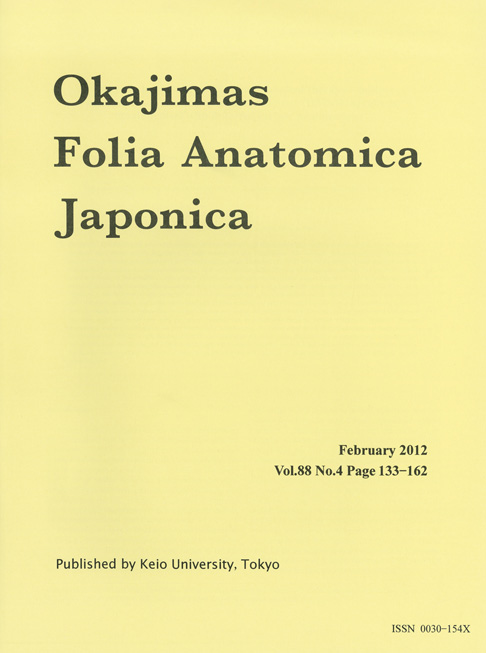巻号一覧
34 巻, 2 号
選択された号の論文の4件中1~4を表示しています
- |<
- <
- 1
- >
- >|
-
1. A Quantitative Study of the Colonization Pattern by Use of Radioactive TracerHirofumi Kikuchi1959 年34 巻2 号 p. 85-94
発行日: 1959年
公開日: 2012/09/24
ジャーナル フリー
1. A large dose (6 mg) of saponin (E. Merk) was administered in a single, intravenous injection into adult albino rabbits, which had been intravenously injected with 200pc of inorganic P in a single dose 24 hours previously.
2. In less than 72 hours after saponin injection, there occurred a striking increase in the amount of radioactivity in the spleen and to a lesser extent also in the liver, whereas the amount of radioactivity in the bone marrow was invariably reduced to a large extent, as compared with the values for the control group without saponin injection.
3. T h e histological examination of various organs revealed a striking accumulation of immature blood cells in the spleen and liver, with a simultaneous depletion of these cells in the bone marrow.
4. The above-mentioned pattern of accumulation of im m ature blood cells in foreign organs after saponin injection was the same as that observed for the transfused marrow cells.
5. The results of radioactivity measure m ents in the spleen, liver and bone marrow was correlated with the histological findings of these organs.抄録全体を表示PDF形式でダウンロード (1444K) -
Reiko Hamaguchi1959 年34 巻2 号 p. 95-123
発行日: 1959年
公開日: 2012/09/24
ジャーナル フリーPDF形式でダウンロード (7940K) -
Goro Hirai1959 年34 巻2 号 p. 125-157
発行日: 1959年
公開日: 2012/09/24
ジャーナル フリーPDF形式でダウンロード (5624K) -
Shigeo Shibata1959 年34 巻2 号 p. 159-176
発行日: 1959年
公開日: 2012/09/24
ジャーナル フリーAnatomical observation wa s conducted on the facial musculature on each side of the face of 32 bodies (14 male,18 female) of Macacus cyclopsis (60 cases).
The following findings were obtained. The facial muscles of primates do not have defin i te muscle fascia such as other skeletal muscles. The evolution of these muscle is reported to be the greatest (Huber) and complicated (Supli van and Osgoo d) at the glabella, the supraorbital region and about the mouth. Similar findings were noted in Macacus cyclopsis. All of these facial muscles are supplied by branches from N. facialis.
1) M. orbicularis oculi This muscle may b e divided into Pars palpebralis, orbitalis, and peripheralis but the former two are unremarkable. Pars peripheralis is called M. malaris and if its Caput laterale has a bony attachment it should be called M. zygomaticus minor. The origin is by Caput mediale and Caput laterale but during its course, it interdigitates with the muscle fibers of M. levator labii sup. alaeque nasi and M. levator labii sup. to form a single muscular mass and runs to the upper lip.
2) M. depressor supercilii This is a part of the fibers from the medial region of M. orbicularis oculi. They intermesh with the muscle fibers of M. frontalis, M. procerus and M. corrugator supercilii at between the brows and it is difficult to separate them.
3) M. corrugator supe r cilii This muscle which should be considered a part of the deep fibers of M. orbicularis oculi interdigitates with the muscle fibers of M. depressor supercilii and M. frontalis.
4) M. procerus This is an unpaired muscle formed by the union of M. levator labii sup. alaeque nasi on each side. This muscle is ill-defined due to the interdigitation of muscle fibers.抄録全体を表示PDF形式でダウンロード (2550K)
- |<
- <
- 1
- >
- >|
